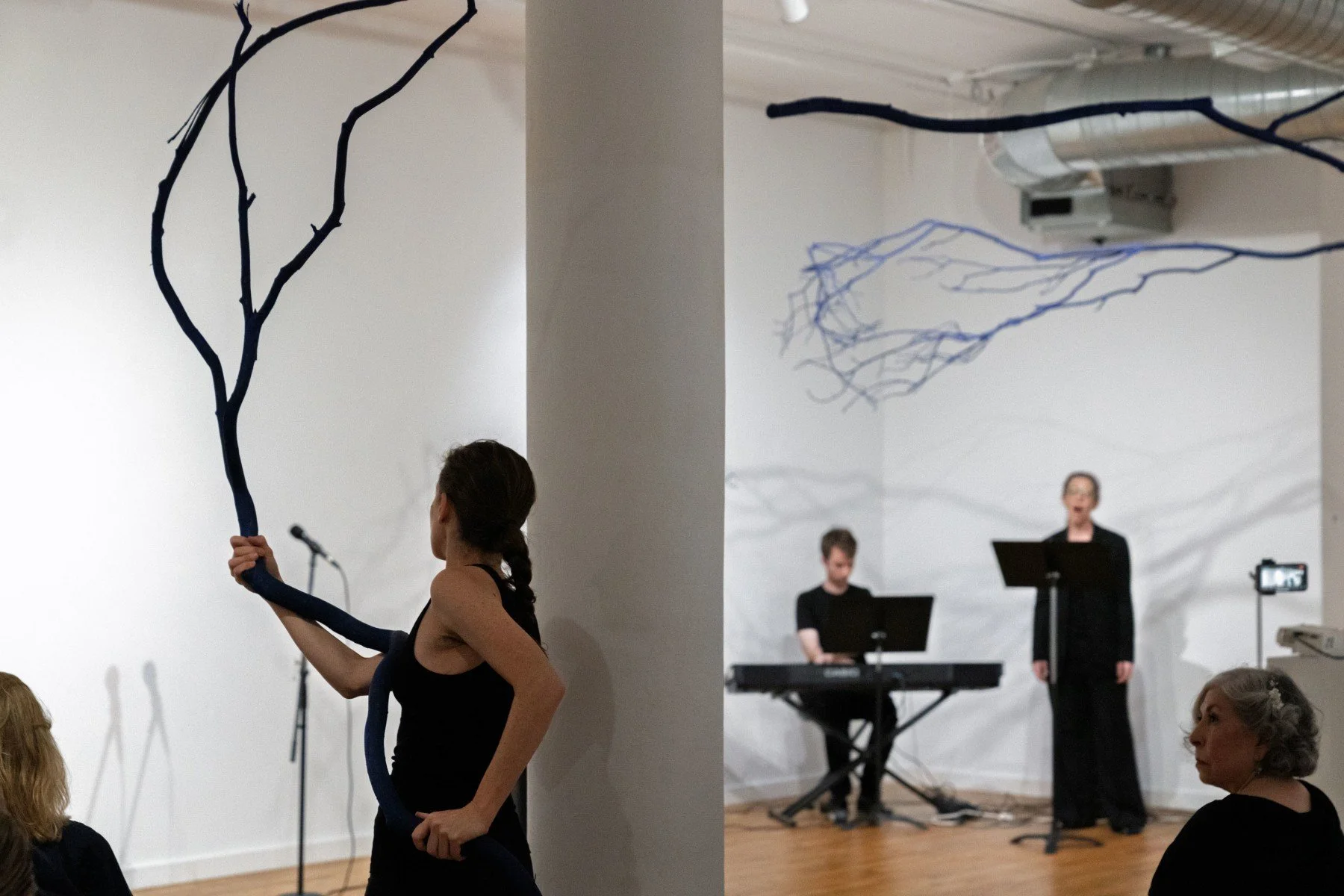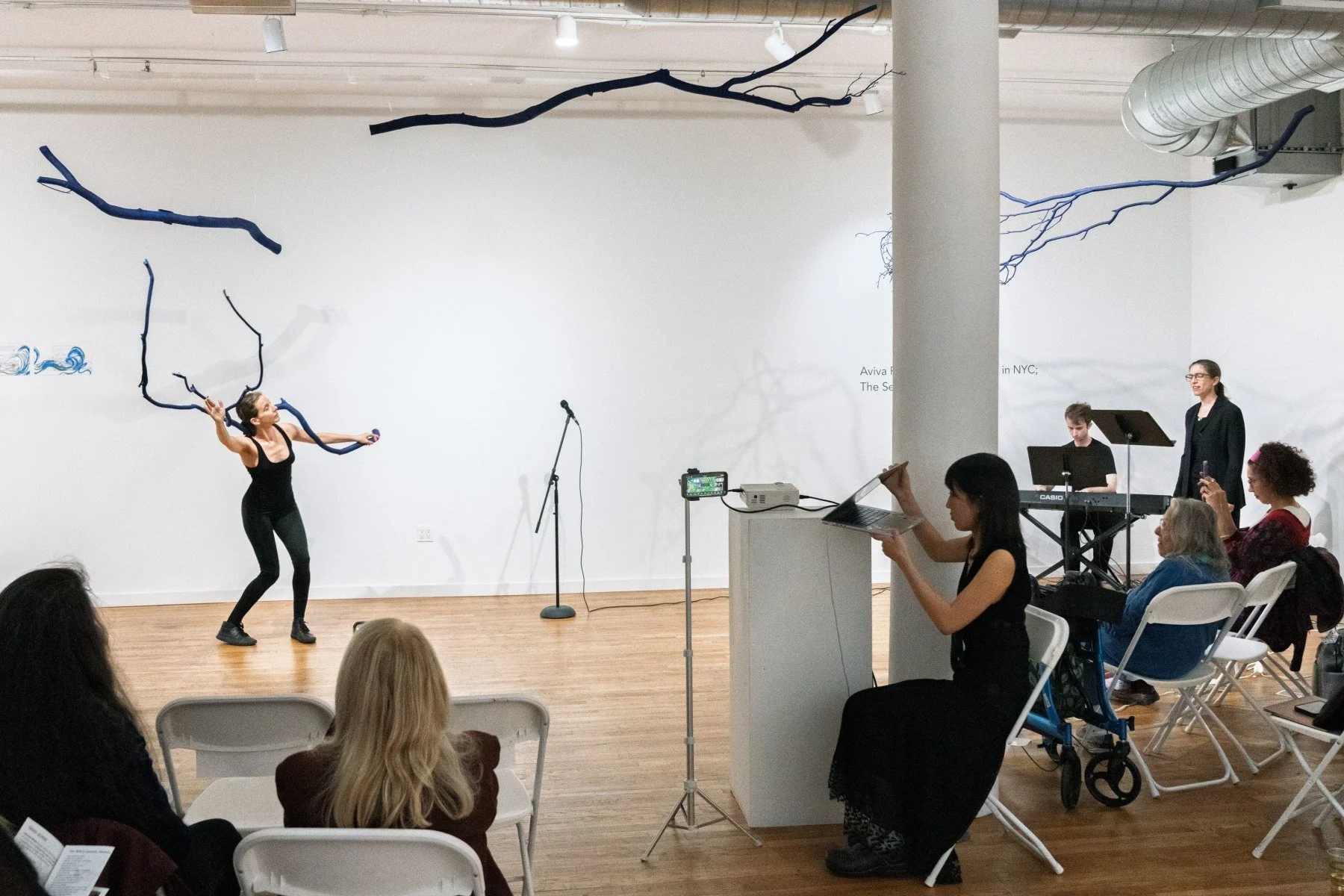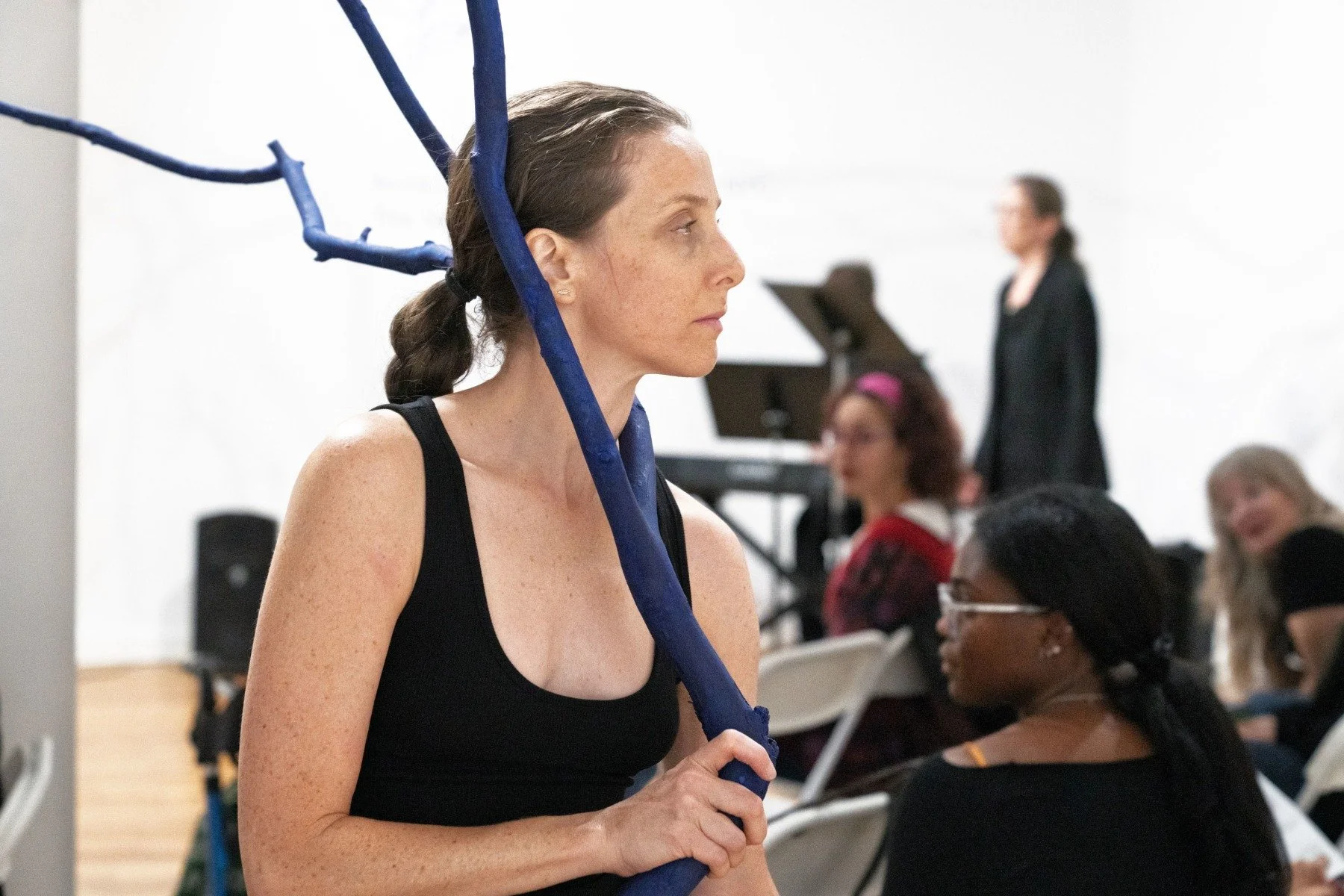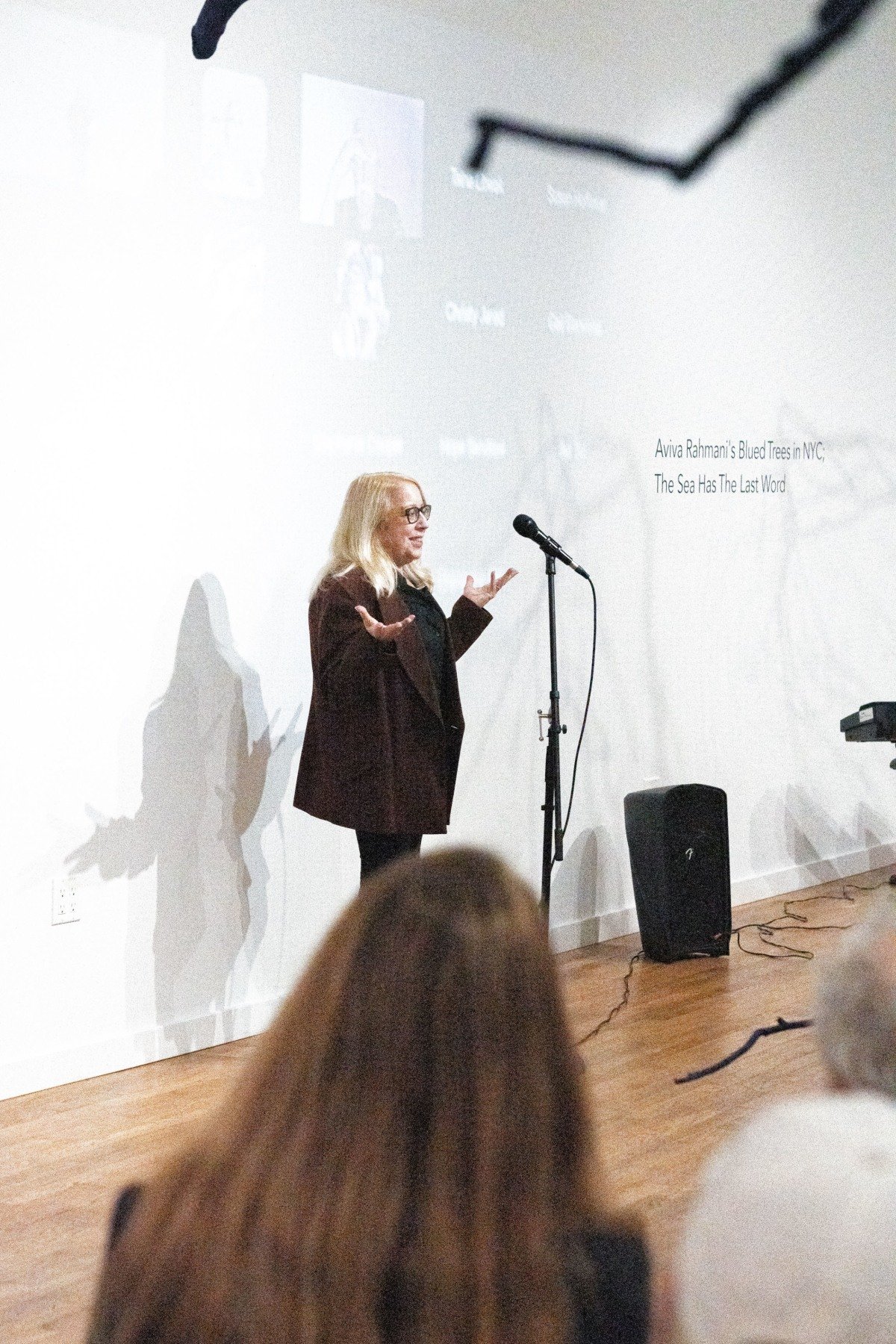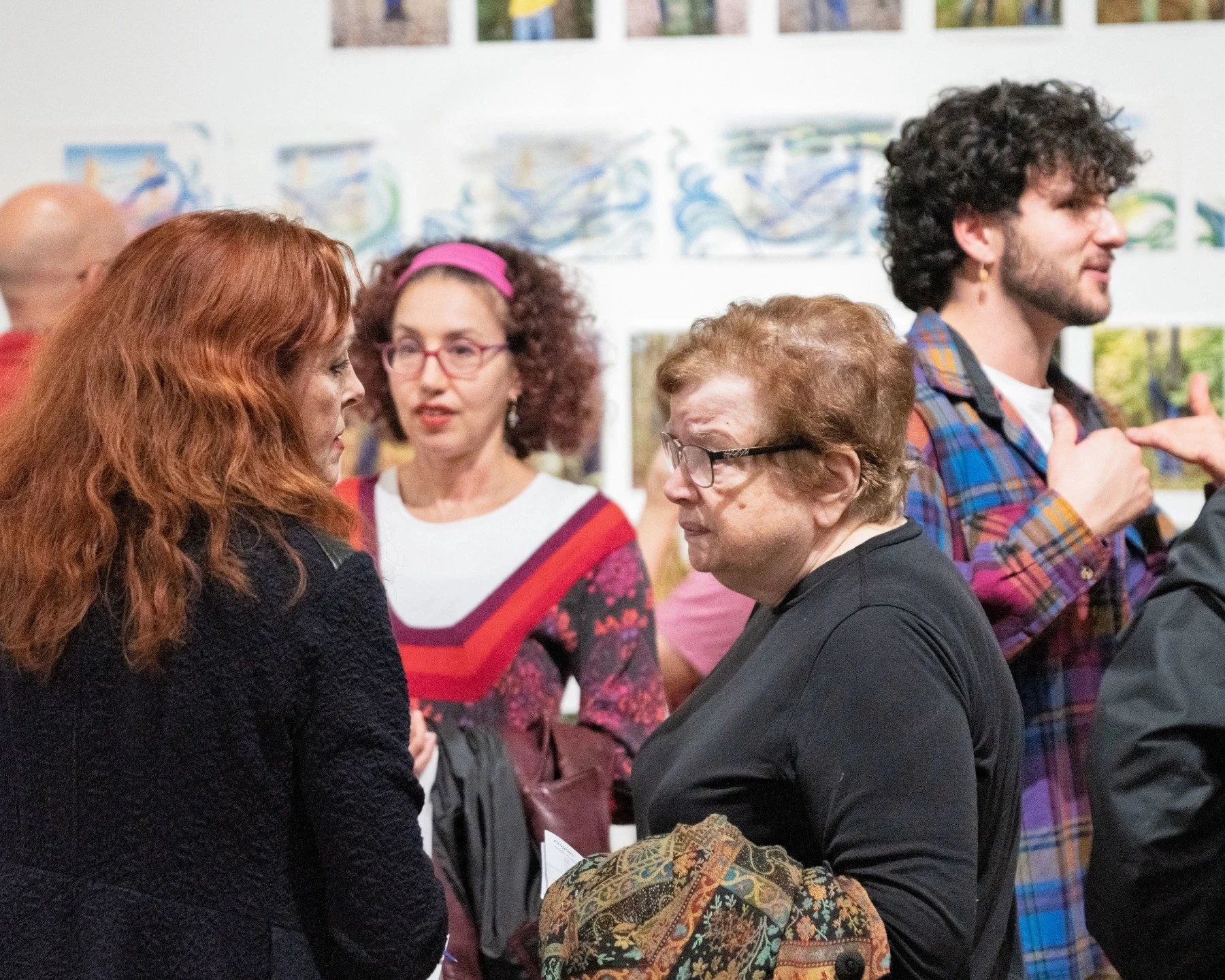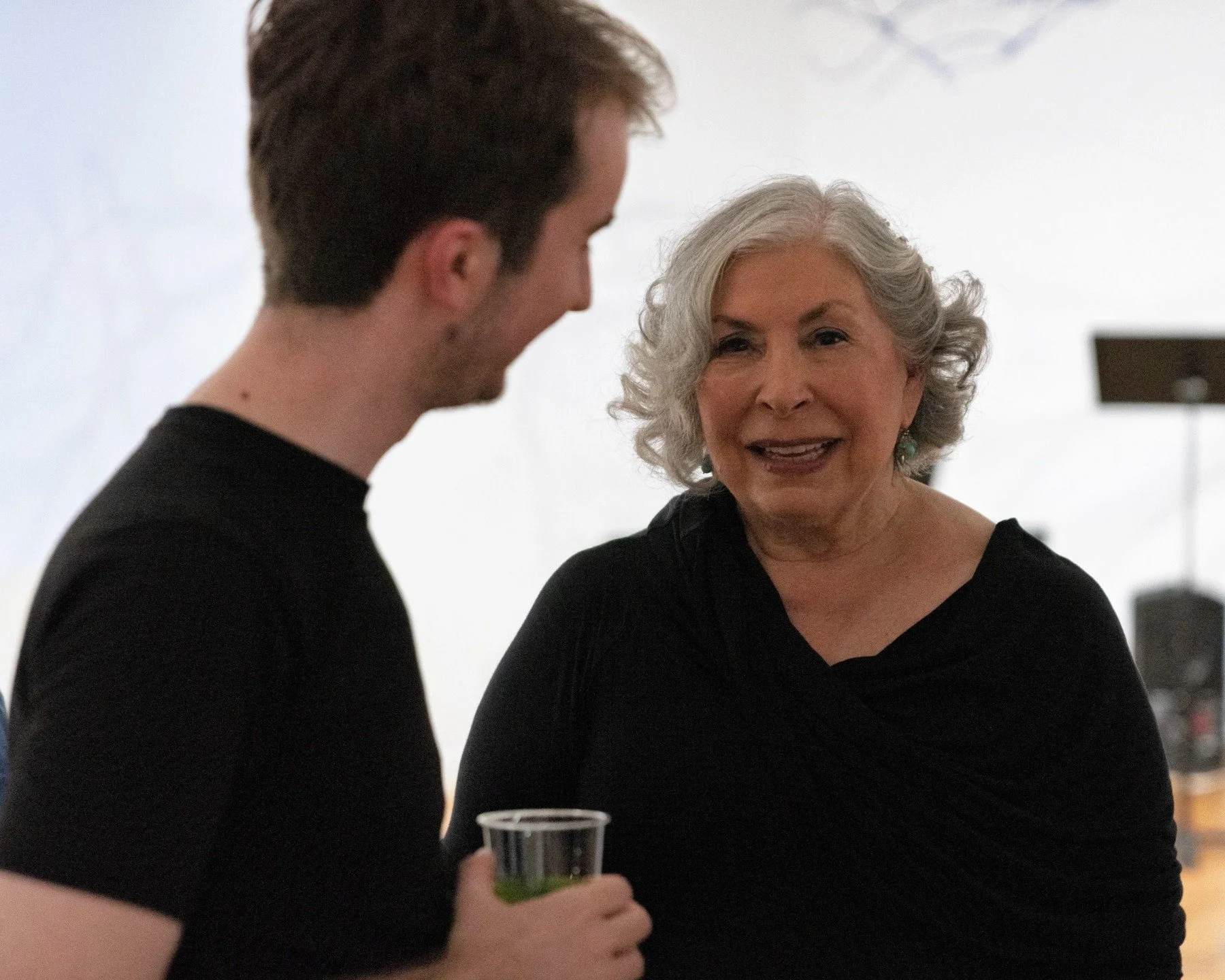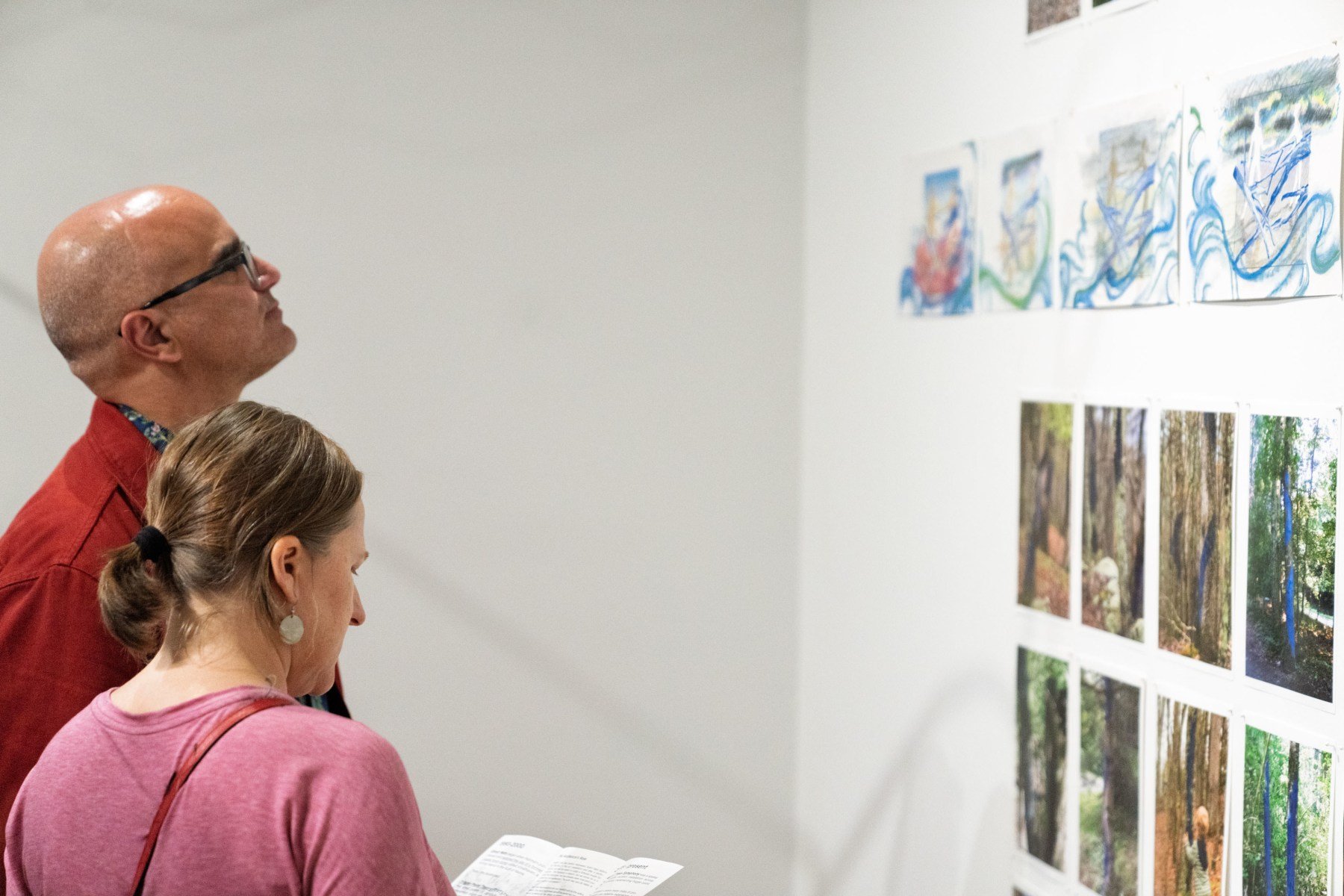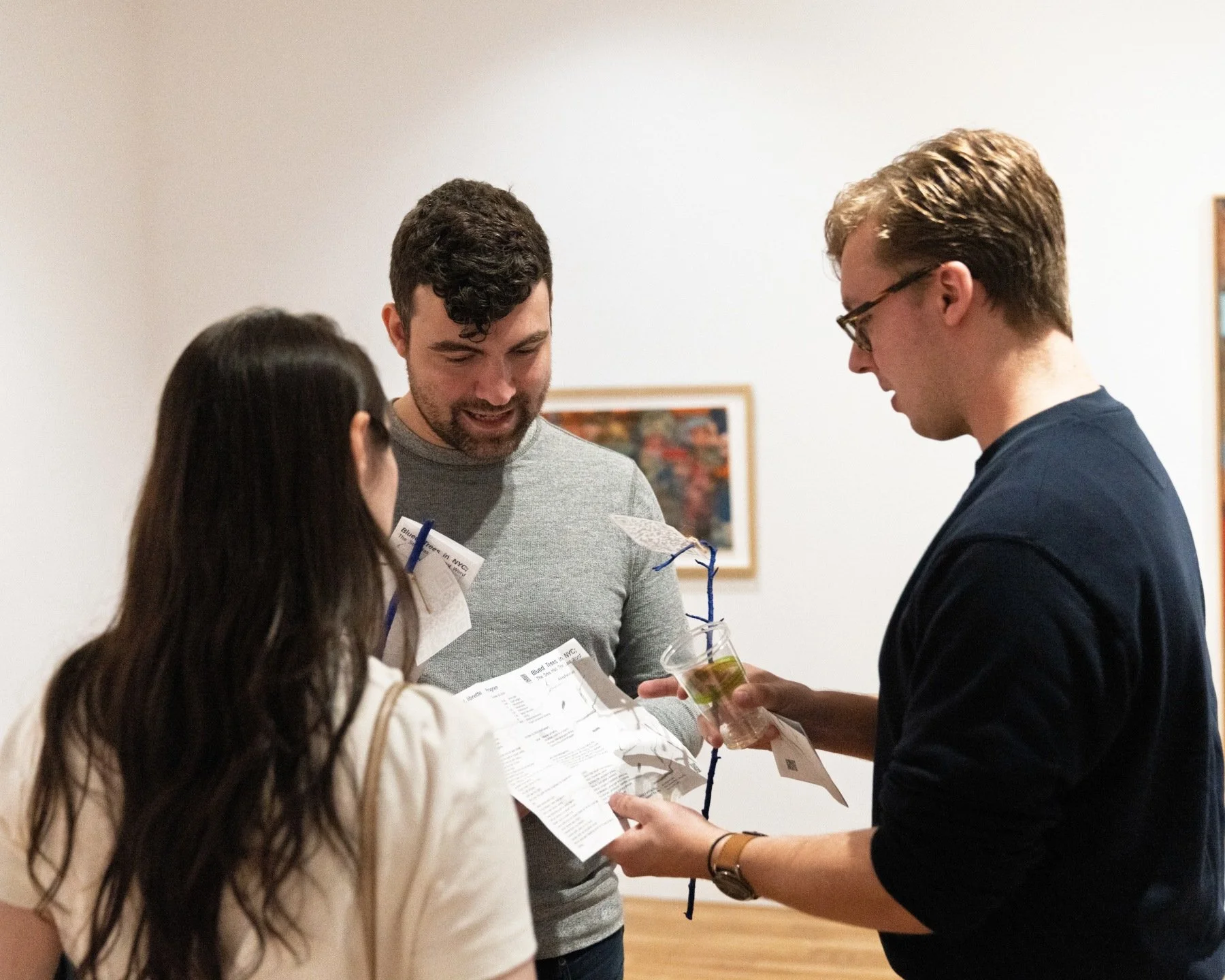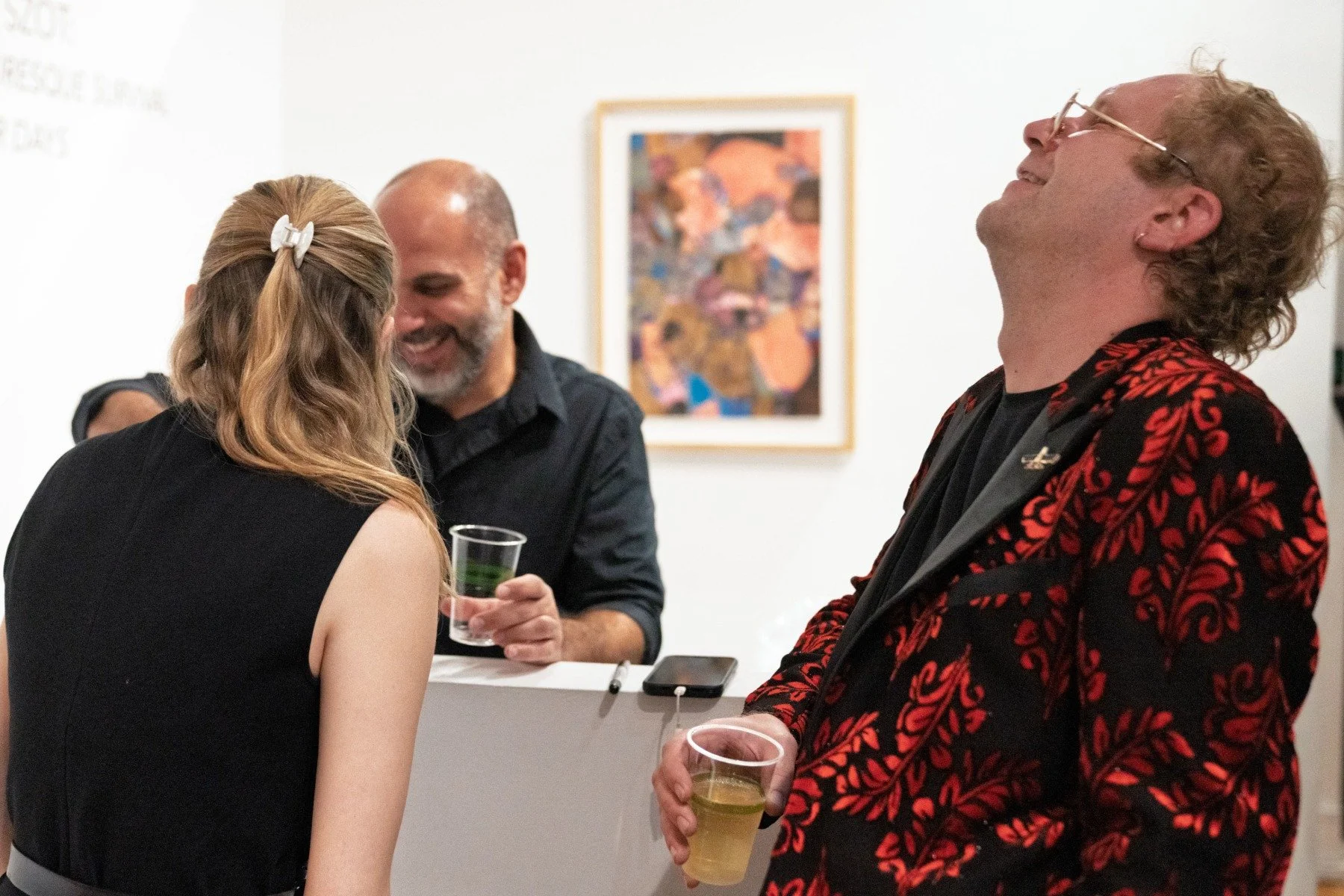
Blued Trees is a project that challenges ecocide.
It is about massacring the environment, and generational conflict.
Blued Trees in NYC; The Sea Has the Last Word
The most recent iteration of Blued Trees was an event on
October 30 2024 at the Anita Rogers Gallery.
Photo Credit: Jon-Paul Rodriguez

Blued Trees, An Opera
In late October, Anita Rogers Gallery hosted Aviva Rahmani's Blued Trees (2015 - present), her collection of embedded dispatches from the front lines of ecological conflict. Rahmani presented excerpts from her Blued Trees opera with dancer Rishauna Zumberg, pianist and arranger Luka Marinkovic, and soloist Alison Cheeseman. Rahmani then moderated an international participatory streaming event to judge a fossil fuel executive and his wife for ecocide– what is the extent of liability?
In peer-reviewed publications and international exhibitions, she has strung connections between climate change activism, aesthetics, and sea level rise:
“In 1990, after a long career in California and New York, I bought a New England town dump, restored the land and made it my work base. This year, my entire studio building with all my life's work almost washed away with winter storms. My sense of urgency, to give art a voice has never been greater.”
Blued Trees was originally inspired by environmental activists, who asked her to create art to stop pipelines. Rahmani created a series of art installations in forest corridors where natural gas pipelines were proposed. She geolocated designated trees in an aerial pattern that corresponded to a copyrightable symphonic score of “tree notes” in 1/3-mile-long measures. Each tree was painted with a blue casein sine wave from the base to the canopy. Her project attracted international attention. In 2018, a Mock Trial granted her an injunction against further forest destruction by a hypothetical pipeline company. The trial inspired her opera-in-progress.
Just before the American presidential election, visitors were invited to immerse themselves in the questions that have driven Rahmani's practice; to decide outcomes for ecocide, view some of the Blued Trees and ‘Are We Lost’ prints, experience arias, and engage in an audience participatory event.
Blued Trees emerged from intimate knowledge that without imminent intervention, we may all drown in a world of dead forests. It was made possible in part through a grant from the Pollock-Krasner Foundation, awarded in 2023, which supported Rahmani in the development of this body of work. Blued Trees in NYC was also made possible by the New York State Council on the Arts with the support of the Office of the Governor and the New York State Legislature.
‘The Wife’s Lament’ performed by Aviva Rahmani.
October 30 2024, will be sung by soloist Alison Cheeseman, with an arrangement by Luka Marinkovich, and the dancer Rishauna Zumberg.
Blued Trees, was originally inspired by environmental activists, who asked Rahmani to create art to stop pipelines. She created a series of art installations in the proposed forest corridors where natural gas pipelines were proposed.
Rahmani geolocated designated trees in an aerial pattern that corresponded to a copyrightable symphonic score in 1/3-mile-long measures. Each tree was painted with a blue casein sine wave from the base to the canopy. Her project attracted international attention. In 2018, a Mock Trial granted her an injunction against further forest destruction by a hypothetical pipeline company. The trial inspired her opera-in-progress.
Conception of Blued Trees, An Opera
The Blued Trees, An Opera emerged as a continuation of Aviva Rahmani’s copyrighted continental scale forest symphonic composition which she initiated in 2015. She witnessed a salvo in the most dramatic story of our times: the impunity of ecocide, when a corporation massacred her tree-notes, destroying her art to install their natural gas pipelines. After a 2018 mock trial for her legal suit, she took five years to assemble the performance team and realize her narrative vision. The opera preview was created in just three feverish months and was first performed in summer 2023.
Read more about Blued Trees here:
History going back to 2015:
https://hyperallergic.com/439553/aviva-rahmani-cardozo-school-of-law-stop-a-pipeline
https://hyperallergic.com/235429/using-art-to-stop-a-pipeline
https://www.nyfa.org/conversations-aviva-rahmanis-blued-trees-178288450088
Legal implications and consequences:
Bogok, Gusti. “Art and Activism: The Blued Trees symphonic movement to put ‘public’ back in ‘public benefit’” readersupportednews.org online publication available at:
Rehearsal and Staging
Open Rehearsal - the Final Rehearsal Before the Performance the Following Day. August 25th, 2023, 8pm, Soapbox Gallery, 636 Dean Street, Brooklyn, NY.
Final review of staging elements for the August 25 and 26 open rehearsal and performance of Blued Trees at the Soapbox Gallery, NYC.
Performance
To view the full Performance video please contact Aviva Rahmani - ghostnets@ghostnets.com - for the password to access the video on Vimeo here.
Opera Performance - Audience Discussion about Ecocide and the Environment
August 26th, 2023, 8pm, Soapbox Gallery, 636 Dean Street, Brooklyn, NY
The Human Drama
Blued Trees, An Opera is about ecocide and generational conflict brings together the human element of ecocide, the people and their decisions. Within the human drama is a court trial of the pipeline company executive being tried for his destruction, massacre, of trees, to build the pipeline.
Synopsis
Gary, the CEO of a large energy corporation, has just learned about the legal case brought against him in an eminent domain dispute. The case involves forest property where he is planning to put in a natural gas pipeline. An experimental artist who made an installation on the property has pressed charges. Gary wins a round of the case, which will continue to be fought and appealed. Gary and his daughter, a young obstetrician, have become estranged due to differing beliefs, they see less and less of each other. He asks his daughter to meet him to discuss plans for her mother’s birthday. In the courtroom, the lawyer cross-examines the artist about the artist’s installation The Blued Trees Symphony and ecocide. Gary tells his lawyer and wife about his drastic decision to settle the case, to try to please his daughter. His wife expresses her concerns. Much later in the story, Gary meets with the artist in her garden. The wife is in a bubble.
Meet The Team
The Creatives
-
Catherine FIlloux
LIBRETTIST
-

Lauren Petty and Shaun Irons
PROJECTION-ISTS
-

Julia Schwartz
COMPOSER
-

Aviva Rahmani
ARTIST
The Performers
-

Joseph Vaz
PIANIST
-

Lianne P. Coble-Dispensa
SOPRANO: DAUGHTER AND LAWYER
-

Catherine Choi-Steckmeyer
MEZZO: WIFE AND ARTIST
-
Ross Benoliel
BARITONE: EXECUTIVE (GARY)
Others
-

Elia Emery Min
SOCIAL MEDIA
-

Felicity Stone
WEB MASTER
-

Richard Pinkowitz
PRODUCER
-

WildcatPR
MARKETING
Background
The Blued Trees, An Opera is based on a previous project by Aviva Rahmani called Blued Trees Symphony which began in 2015.
The project has received support from the Pollock Krasner Foundation.
Blued Trees Symphony is a spatial and acoustic outdoor installation across North America, embodying trigger point theory. The installation covers many miles of proposed pipeline expansions, exploring how art, science, and law can change environmental policies about fossil fuels. The installation is composed of trees marked with a painted vertical sine wave. Each marked tree is GPS located, indicating an aerial musical score for an overture. Using copyright law, the artwork on the trees is protected, subsequently protecting the land from eminent domain takings for pipeline development.
The Blued Trees Symphony launched on the Summer Solstice, June 21, 2015, with an overture in Peekskill, New York. It is now installed in many miles of proposed pipeline expansions. Each 1/3 measure of those miles have been copyrighted for protection as a single work of art. Variations of each movement are based on an iterative score created for the overture. All installations are created at the invitation of landowners. The overture was accompanied by an international Greek Chorus at a total of twenty sites internationally. Individual trees were painted and musical variations of the score were performed to echo the theme of connectivity to all life. The score is simultaneously spatial and acoustic and concluded with a coda, a final movement that recapitulated and resolved previous formal themes, on the American presidential Election Day, November 2016.
The Peekskill site for the overture was chosen because the pipelines would pass 105 feet from the infrastructure of the failing Indian Point Energy Center, a nuclear facility thirty miles from New York City. The score corresponded to a pattern that would have prevented the movement of heavy machinery. The paint for each vertical sine wave is a casein slurry of nontoxic ultramarine blue and buttermilk that grows moss (based on a Japanese gardening technique).
Bibliography
2023
Stoltz, Barbara "A Nature Thing: What Does Contemporary Ecological Art Produce?" Rethinking Materiality in Modern and Contemporary Art Arts, edited by Dr. Ronit Milano and Dr. Nissim Gal
Rahmani, Aviva "There Will be No Managed Retreat." Bodies in (and out of) Place" Issue #16 , May 2023 Part I dark Matter
2022
Rahmani, Aviva Divining Chaos, New Village Press
Rahmani, Aviva Ecoart in Action, New Village Press, co-edited with Geffen, Amara, Chris Fremantle and Rosenthal, Ann
2021
Rahmani, Aviva “The Blued Trees Symphony as Transdisciplinary Mediation for Environmental Policy.” Media+Environment 3 (1). https://doi.org/10.1525/001c.25256
2019
Rahmani, Aviva “A Blued Trees Policy,” Art, Theory and Practice in the Anthropocene Edited by Reiss, Julie Vernon Press, Malaga, Spain and Wilmington, DE.)
2018
Rahmani, Aviva “Rocks, Radishes, Restoration: on the relationships between clean water and healthy soil." Conversation between Aviva Rahmani and Ray Weil in: Toland, Noller & Wessolek, Field to Palette (CRC Press)
Akiba, Michiko “Blued Trees Symphony” BIOCITY, Bookend Publishing Co., Ltd, Tokyo, No.75
2017
Bajaj, Jaya “Art, Copyright, and Activism: Could the Intersection of Environmental Art and Copyright Law Provide a New Avenue for Activists to Protest Various Forms of Exploitation?” 15 Nw. J. Tech. & Intell. Prop. 53 https://scholarlycommons.law.northwestern.edu/njtip/vol15/iss1/3/
2016
Lim, Audrea. “How Land Art Lived and Died to Stop a Fracked Gas Pipeline and How It Lives Again” Village Voice: https://www.villagevoice.com/2016/06/29/how-land-art-lived-and-died-tostop-a-fracked-gas-pipeline-and-how-it-lives-again June 29, 2016.
Denson, Roger. “Earth Day EcoArt Confronts Deforestation, Fracking, Nuclear Hazards In Eastern US Woodlands,” Huffington Post online publication available at: https://www.huffpost.com/entry/earth-day-ecoart-confront_b_9721354 April 21, 2016.
Please donate to Blued Trees as we continue our fight against ecocide.

Blued Trees Symphony
The Blued Trees project began in 2015 with a symphony. It is now an opera-in-progress called ‘Blued Trees, An Opera’.
The project has received support from the Pollock Krasner Foundation and from the New York State Council for the Arts.
Blued Trees Symphony is a spatial and acoustic outdoor installation across North America, embodying trigger point theory. The installation covers many miles of proposed pipeline expansions, exploring how art, science, and law can change environmental policies about fossil fuels. The installation is composed of trees marked with a painted vertical sine wave. Each marked tree is GPS located, indicating an aerial musical score for an overture. Using copyright law, the artwork on the trees is protected, subsequently protecting the land from eminent domain takings for pipeline development.
The Blued Trees Symphony launched on the Summer Solstice, June 21, 2015, with an overture in Peekskill, New York. It is now installed in many miles of proposed pipeline expansions. Each 1/3 measure of those miles have been copyrighted for protection as a single work of art. Variations of each movement are based on an iterative score created for the overture. All installations are created at the invitation of landowners. The overture was accompanied by an international Greek Chorus at a total of twenty sites internationally. Individual trees were painted and musical variations of the score were performed to echo the theme of connectivity to all life. The score is simultaneously spatial and acoustic and concluded with a coda, a final movement that recapitulated and resolved previous formal themes, on the American presidential Election Day, November 2016.
The Peekskill site for the overture was chosen because the pipelines would pass 105 feet from the infrastructure of the failing Indian Point Energy Center, a nuclear facility thirty miles from New York City. The score corresponded to a pattern that would have prevented the movement of heavy machinery. The paint for each vertical sine wave is a casein slurry of nontoxic ultramarine blue and buttermilk that grows moss (based on a Japanese gardening technique).
Links

Musical line of the overture for the Blued Trees Symphony Date: June 2015 Size: variable Materials: photoshop Description: The Algonquin (AIM) pipeline that was the subject of the Blued Trees Symphony. The overture was conceptualized as iterated measures of the score from the Blue Mountain Reservation to the infrastructure for the Indian Point nuclear facility, indicated in red to the left of the image, within 105’ of the pipeline. The corridor extends West under the Hudson River, and North and East across the remainder of New England. Aviva Rahmani with Daisy Morton.

Blued Trees Symphonic Score for a Forest Date: Composed 2015 Size: 1/3 mile of tree-notes Materials: Aerial map-score of the distribution of trees designated in woodlands for painting as tree-notes with a casein slurry of buttermilk and non-toxic ultramarine blue pigment. Description: The synesthetic pattern of each 1/3 mile “measure” of the symphonic musical line was designed as both a melodic refrain and to prevent the passage of heavy machinery in increments of 1/3 mile . The score was iterated, with variations based on terrain, at every site and with various instruments. Submitted as part of the copyright material to register the ,Blued Trees Symphony.Composed and mapped by Aviva Rahmani.

Bass Notes, Blued Trees Symphony Detail 3 Location Oneida County, New York Site 1 Date: October 2015 Size: Detail of 1/3 mile measure Materials: Trees painted with a casein slurry of buttermilk and non-toxic ultramarine blue pigment designed to grow mosses. Description: Detail of Blued Trees installation of the first symphonic movement of Blued Trees, on the second of three sites in Oneida County, New York, location of proposed Dominion New Market pipeline. Photo by Aviva Rahmani.

Blued Trees November 9 Detail 4 Date: 2015 Size: 1/3 mile Materials: Trees painted with a casein slurry of buttermilk and non-toxic ultramarine blue pigment designed to grow mosses. Description: detail of tree-notes from Blued Trees overture as seen Nov. 9, 2015, after submission of cease and desist notice to the Algonquin and Spectra pipeline corporations and in-plead to the court to protect the registered copyright on the overture. Photo by Erik McGregor.
Publications
Denson, Roger. “Earth Day EcoArt Confronts Deforestation, Fracking, Nuclear Hazards In Eastern US Woodlands,” Huffington Post online publication available at: http://www.huffingtonpost.com/g-roger-denson/earth-day-ecoart-confront_b_9721354.html April, 21, 2016.
Williams, Wes. “Landowners Put Hope in Art Project to Combat Pipeline,” WVTF.org online publication available at: http://wvtf.org/post/landowners-put-hope-art-project-combat-pipeline#stream/0 April, 19, 2016
Collins, Shay. “Aviva Rahmani’s Blued Trees and the Fight Against Pipelines” The Cornell Daily Sun online publication available at: http://cornellsun.com/2015/12/03/aviva-rahmanis-blued-trees-and-the-fight-against-pipelines/ December 3, 2015.
Rahmani, Aviva. "Blued Trees on the front lines journal excerpts" The Brooklyn Rail online publication available at: November 5th, 2015.
Baumgardner, Julie. “Nine Artists Respond to Climate Change” Artsy online publication available at: September 22, 2015.
Steinhauer, Jillian. "Art to Stop a Pipeline" Hyperallergic online publication available at: September 9, 2015.
Rahmani, Aviva. “Blued Trees” CSPA Quarterly Issue 12, August 3, 2015.
Bogok, Gusti. “Art and Activism: The Blued Trees symphonic movement to put ‘public’ back in ‘public benefit’” readersupportednews.org online publication available at: http://readersupportednews.org//index.php?option=com_content&task=view&id=32089 August 28, 2015.
Clarity. “’Blued Trees.’ Art to Stop a Pipeline?” Sane Energy Project online publication available at: July 26, 2015.
Background:
Lost & Threatened Plants and Animals
Species biodiversity is important to preserve resilience for the health of the planet, its ecologies, and human life. Pressure from human activities is causing an ever-accelerating threat to many different species of plants and animals. The giant panda or the polar Bear may be the most emblematic of critically endangered animals in the popular imagination, but many other charismatic animals are endangered by anthropogenic activities such as the blue macaw, Sumatran tiger, green sea turtle, spotted owl, and California condor. Still, they are only the top of an iceberg that includes countless insects critical to pollination as well as many other mammals and plants that attract less attention and reverence. At the time of this writing, the International Union for Conservation of Nature (IUCN) has assessed 120,372 species of animals and plants and have awarded the status of “threatened” to 32,441 — over 25 percent. The figures of species under threat of extinction are staggering. For example, 25 percent of mammals, 41 percent of amphibians, and 13 percent of birds.
Through many of her ecoart projects, Aviva Rahmani has flagged the crises that life on Earth faces, particularly over the ecosystems that protect both fresh and saltwater, such as estuaries. She confronts the vital importance and interconnectedness of complex roles that different species play in healthy ecosystems. Many of her projects explore how art can catalyse change in the environment and positively impact or even reverse our movement toward plant and animal extinction.
Click the above image to view the virtual exhibition ‘Scenes from a Marriage of Art and Science’.
This exhibition features photographs of installations, drypoint etchings and digital artwork by Aviva Rahmani. In particular these works explore themes of endangered species, water ecosystem preservation and climate change.































